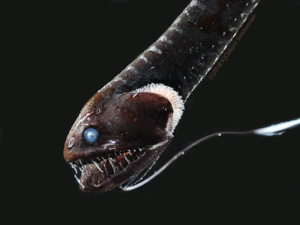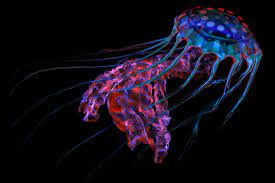
Lurking in darkness, invisible in the abyss, elusive in the deep ocean, researchers discovered 16 new species of ultra-black fish for the first time during a fishing expedition. In an evolutionary arms race between predator and prey, some species of deep-sea fish evolved an invisibility cloak by using ultra-black skin pigmentation.
The deep sea, the ocean biome where solar light does not reach and photosynthesis does not occur, is a region of inhospitality and of survival. Fish in the deep ocean only have three survival strategies: outmaneuver their opponent, be bigger and stronger than their adversary, or be invisible. Two of these strategies require a large amount of food and energy, but the most energy efficient way is to be undetected in the desolate wasteland of the oceans deep.

To become invisible, these fish must be innovative by using the same pigment as what is found in your skin, melanin. In order to achieve their invisibility in the deep ocean these fish have evolved a novel mechanism to use their melanosomes, the cells that carry the melanin. By increasing their intracellular melanin density and altering the cellular shape to be more capsule shaped rather than rounded allows for alterations in the reflected light path. Light that normally would be reflected out the melanosomes, now with the altered shape is reflected into adjacent melanosomes where it is further absorbed. By doing so, they are able to absorb over 99.5% of light or reflect only 0.5% of light. In comparison, typical black paper reflects about 10% of light, 20-fold higher! Thus, increasing the amount of total light absorbed by the fish, giving it its ultra-black pigmentation. However, these fish aren’t the only animals to evolve ultra-black pigmentation; some birds of paradise, butterflies, and spiders have evolved similar traits.

While the ultra-dark pigmentation adaptation may seem like just aesthetics, it plays a critical role in the evolutionary arms race in the deep ocean. Even though surface light does not reach below 1,000 meters, the deep ocean is vibrant. The light from volcanic vents and other sources of bioluminescence, prevent the deep ocean from being completely devoid of light. If no light was present, there would be no need for the adaptation as everything would be completely black. The ultra-black pigmentation allows for enhanced camouflage in an already low visibility environment which allows for a stealthy approach to evade predation and for ambushing predators.
Outside of the ocean, ultra-black materials are incredibly useful in material science and astrophysics, such as coating the inside of a telescope with vantablack paint to reduce background noise; biomimicry of these deep-sea fish may prove to be more than just aesthetics.
Peer Editor: Ivanna Zhilinskaya